headlights BUICK PARK AVENUE 1994 Owners Manual
[x] Cancel search | Manufacturer: BUICK, Model Year: 1994, Model line: PARK AVENUE, Model: BUICK PARK AVENUE 1994Pages: 324, PDF Size: 17.01 MB
Page 65 of 324
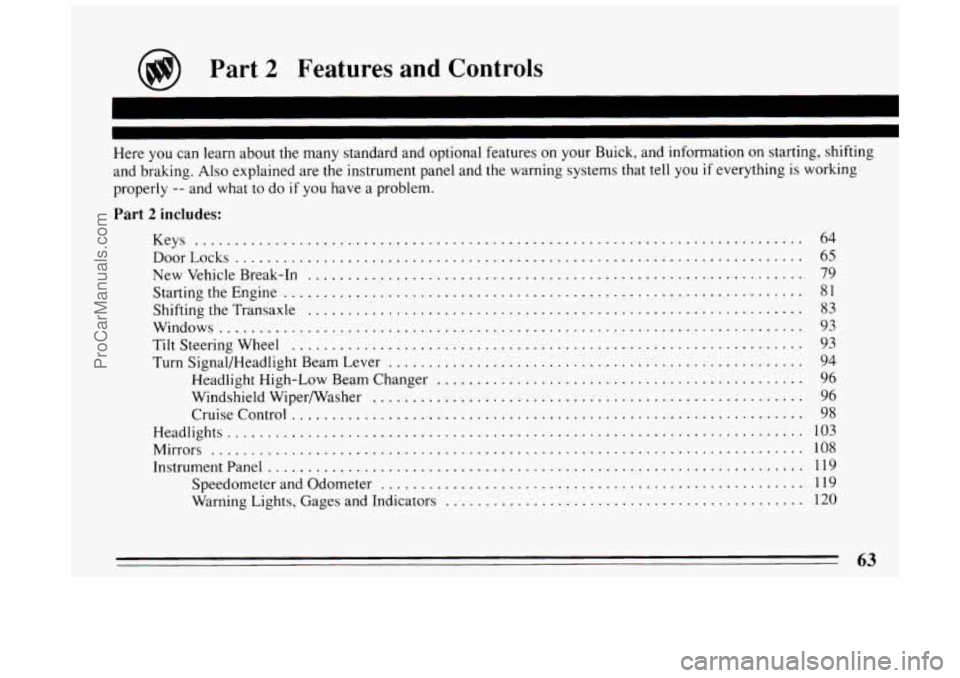
Part 2 Features and Controls
Here you can learn about the many standard and optional features on your Buick. and information on starting. shifting
and braking
. Also explained are the instrument panel and the warning systems that tell you if everything is working
properly
.. and what to do if you have a problem .
Part 2 includes:
Keys ........................................................................\
.... 64
DoorLocks
....................................................................... \
65
NewVehicleBreak-In
.............................................................. 79
StartingtheEngine
................................................................. 81
Shifting the Transaxle .............................................................. 83
Windows ........................................................................\
. 93
93
Turn Signal/Headlight Beam Lever
.................................................... 94
Headlight High-Low Beam Changer
.............................................. 96
Windshield Wipermasher
...................................................... 96
Cruisecontrol
................................................................ 98
Headlights
........................................................................\
103
Mirrors
........................................................................\
.. 108
Instrumentpanel ................................................................... 119
Speedometer and Odometer ..................................................... 119
Warning Lights, Gages and Indicators ............................................. 120
TiltSteeringWheel ................................................................
. . 63
ProCarManuals.com
Page 97 of 324
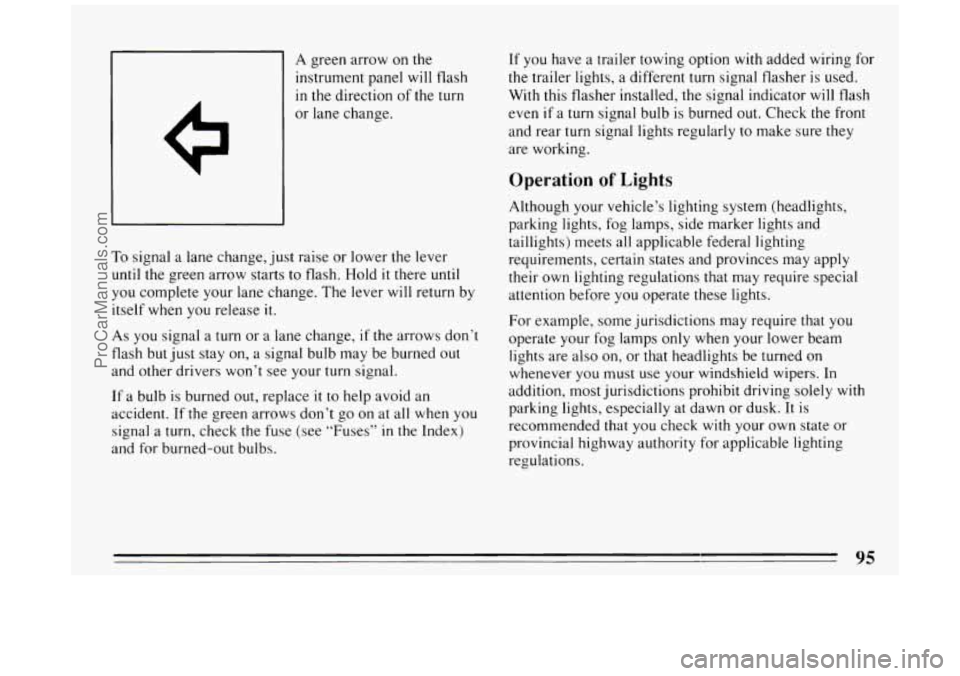
A green arrow on the
instrument panel will flash
in the direction of the turn
To signal a lane change, just raise or lower the lever
until the green arrow starts to flash. Hold it there until
you complete your lane change. The lever will return by
itself when you release
it.
As you signal a turn or a lane change, if the arrows don’t
flash but just stay on, a signal bulb may be burned out
and other drivers won’t see your turn signal.
If a bulb is burned out, replace it to help avoid an
accident. If the green arrows don’t go on at all when you
signal a
turn, check the fuse (see “Fuses” in the Index)
and for burned-out bulbs. If you
have a trailer towing option
with added wiring for
the trailer lights, a different turn signal flasher is used.
With this flasher installed, the signal indicator
will flash
even
if a turn signal bulb is burned out. Check the front
and rear turn signal lights regularly to make sure they
are working.
Operation of Lights
Although your vehicle’s lighting system (headlights,
parking lights, fog lamps, side marker lights and
taillights) meets all applicable federal lighting
requirements, certain states and provinces may apply
their own lighting regulations that may require special
attention before you operate these lights.
For example, some jurisdictions may require that you
operate your fog lamps only when your lower beam
lights are also on, or that headlights be turned on
whenever you must
use your windshield wipers. In
addition, most jurisdictions prohibit driving solely
with
parking lights, especially at dawn or dusk. It is
recommended that you check with your own state or
provincial highway authority for applicable lighting
regulations.
95
ProCarManuals.com
Page 98 of 324
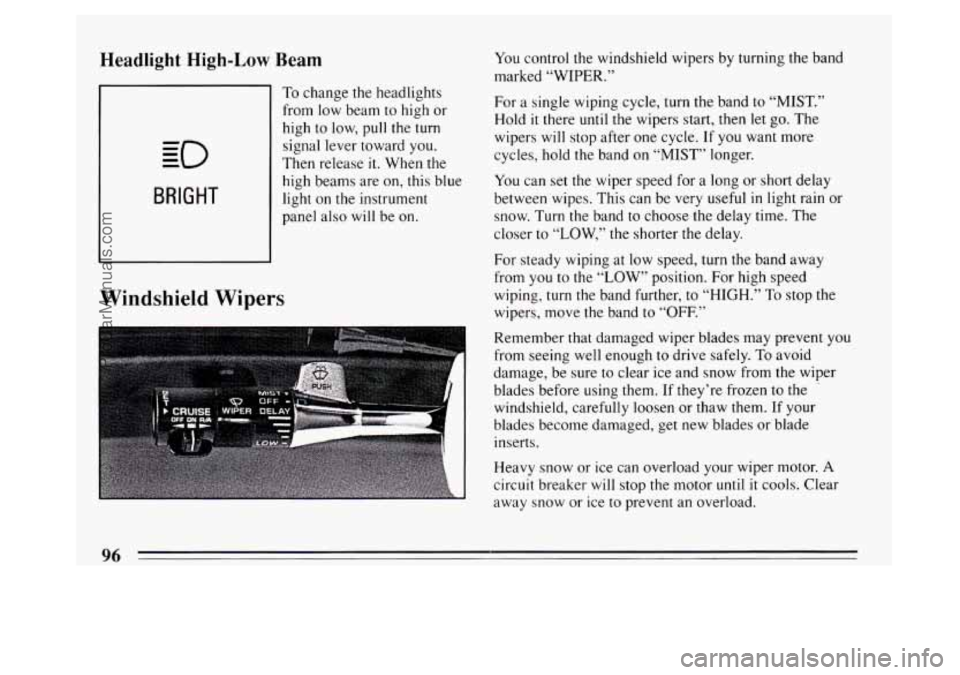
Headlight High-Low Beam
BRIGHT
Windshield Wipers
To change the headlights
from low beam to high or
high to low,
pull the turn
signal lever toward you.
Then release
it. When the
high beams are on, this blue
light on the instrument
panel also will be on. You
control the windshield wipers by turning the band
marked
“WIPER.”
For a single wiping cycle, turn the band to “MIST.”
Hold
it there until the wipers start, then let go. The
wipers will stop after one cycle. If you want more
cycles, hold the band on “MIST” longer.
You can set the wiper speed for a long or short delay
between wipes. This can be very useful
in light rain or
snow. Turn the band to choose the delay time. The
closer to
“LOW,” the shorter the delay.
For steady wiping at low speed, turn the band away
from you to the
“LOW” position. For high speed
wiping, turn the band further,
to “HIGH.” To stop the
wipers, move the band to “OFF.”
Remember that damaged wiper blades may prevent you
from seeing well enough to drive safely.
To avoid
damage, be sure to clear ice and snow from the wiper
blades before using them. If they’re frozen to
the .
windshield, carefully loosen or thaw them. If your
blades become damaged, get new blades or blade
inserts.
Heavy snow or ice can overload your wiper motor.
A
circuit breaker will stop the motor until it cools. Clear
away snow or ice to prevent an overload.
96
ProCarManuals.com
Page 105 of 324
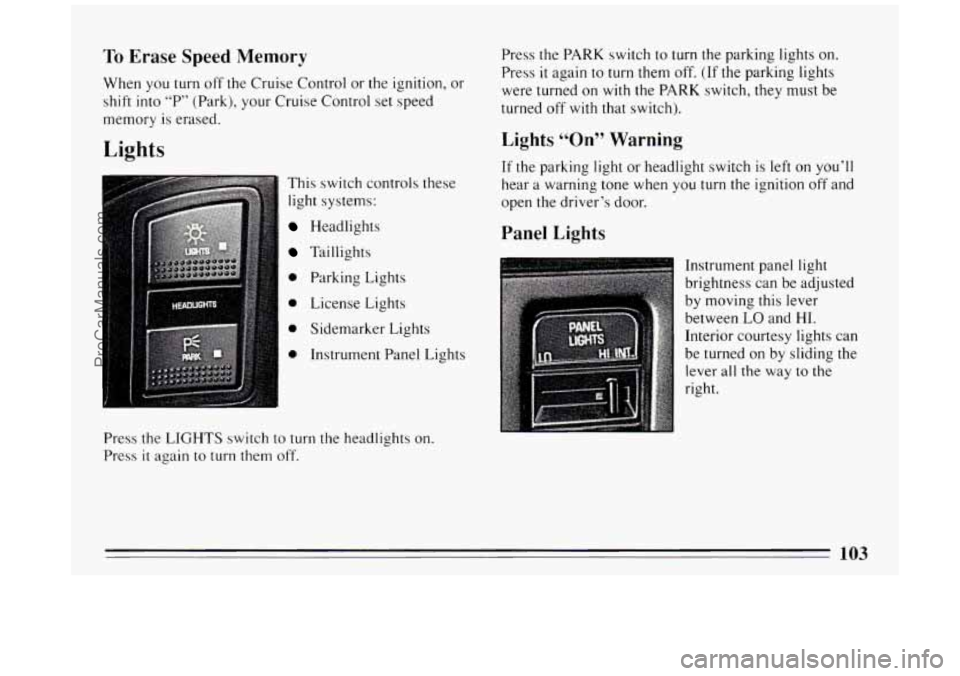
To Erase Speed Memory
When you turn off the Cruise Control or the ignition, or
shift into “P” (Park), your Cruise Control set speed
memory is erased.
Lights
This switch controls these
light systems:
Headlights
Taillights
0 Parking Lights
0 License Lights
0 Sidemarker Lights
0 Instrument Panel Lights
Press the LIGHTS switch to
turn the headlights on.
Press it again to turn them off. Press the
PARK switch to turn the parking lights
on.
Press it again to turn them off. (If the parking lights
were turned
on with the PARK switch, they must be
turned off with that switch).
Lights “On” Warning
If the parking light or headlight switch is left on you’ll
hear
a warning tone when you turn the ignition off and
open the driver’s door.
Panel Lights
Instrument panel light
brightness can be adjusted
by moving this lever
between
LO and HI.
Interior courtesy lights can
be turned on by sliding the
lever all the way to the
right.
103
ProCarManuals.com
Page 107 of 324
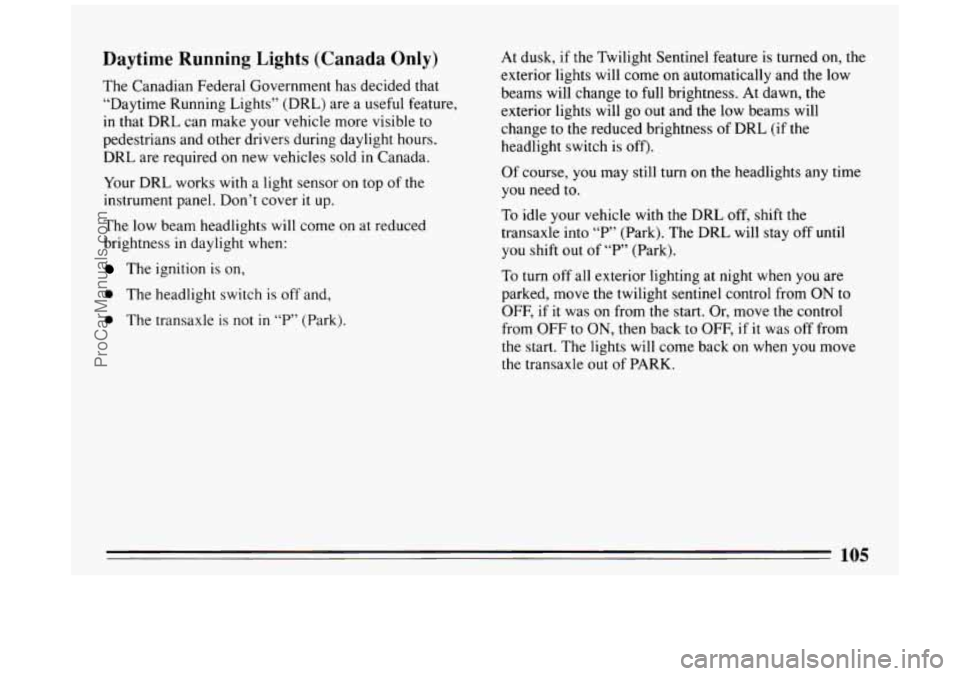
Daytime Running Lights (Canada Only)
The Canadian Federal Government has decided that
“Daytime Running Lights” (DRL) are a useful feature,
in that DRL can make your vehicle more visible to
pedestrians and other drivers during daylight hours.
DRL are required
on new vehicles sold in Canada.
Your DRL works with a light sensor on top of the
instrument panel. Don’t cover
it up.
The low beam headlights will come on at reduced
brightness in daylight when:
The ignition is on,
0 The headlight switch is off and,
0 The transaxle is not in “P” (Park). At
dusk, if the Twilight Sentinel feature is turned on, the
exterior lights will come on automatically and the low
beams will change to
full brightness. At dawn, the
exterior lights will go out and the low beams will
change to the reduced brightness
of DRL (if the
headlight switch is
off).
Of course, you may still turn on the headlights any time
you need to.
To idle your vehicle with the DRL off, shift the
transaxle into
“P’ (Park). The DRL will stay off until
you shift out
of “P’ (Park).
To turn off all exterior lighting at night when you are
parked, move
the twilight sentinel control from ON to
OFF,
if it was on from the start. Or, move the control
from OFF to
ON, then back to OFF, if it was off from
the start. The lights will come back on when
you move
the transaxle out of PARK.
105
ProCarManuals.com
Page 111 of 324
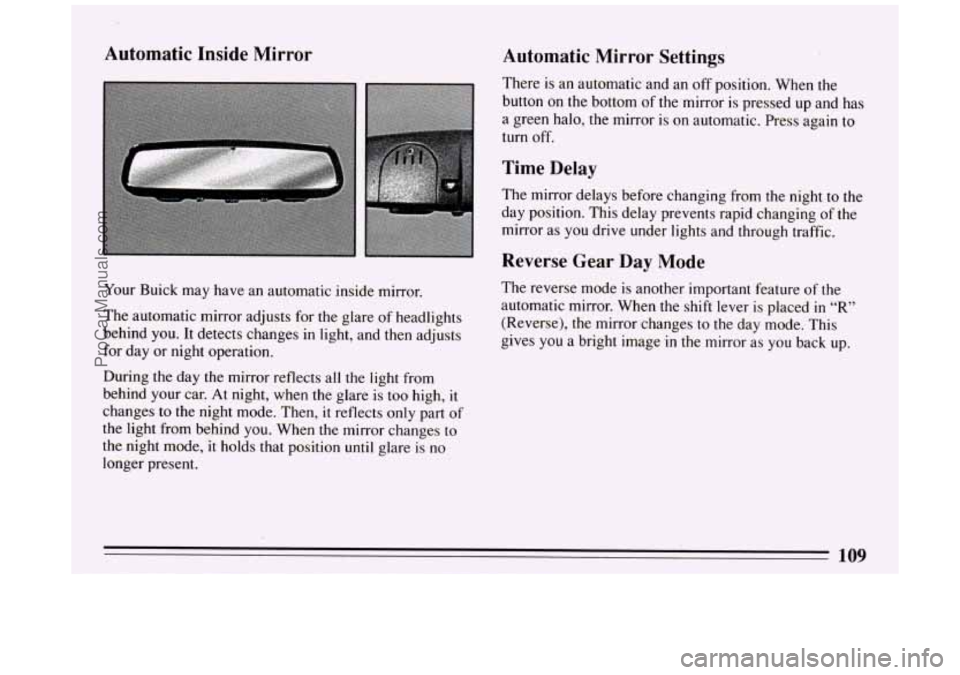
Automatic Inside Mirror
Your Buick may have an automatic inside mirror.
The automatic mirror adjusts for the glare of headlights
behind you. It detects changes in light, and then adjusts
for day or night operation.
During the day the mirror reflects all the light from
behind your car. At night, when the glare is too high, it
changes to the night mode. Then, it reflects only part of
the light from behind you. When the mirror changes
to
the night mode, it holds that position until glare is no
longer present.
Automatic Mirror Settings
There is an automatic and an off position. When the
button
on the bottom of the mirror is pressed up and has
a green halo,
the mirror is on automatic. Press again to
turn off.
Time Delay
The mirror delays before changing from the night to the
day position. This delay prevents rapid changing of the
mirror as
you drive under lights and through traffic.
Reverse Gear Day Mode
The reverse mode is another important feature of the
automatic mirror. When
the shift lever is placed in “R”
(Reverse), the mirror changes to the day mode. This
gives you a bright image in the mirror as you back up.
109
ProCarManuals.com
Page 177 of 324
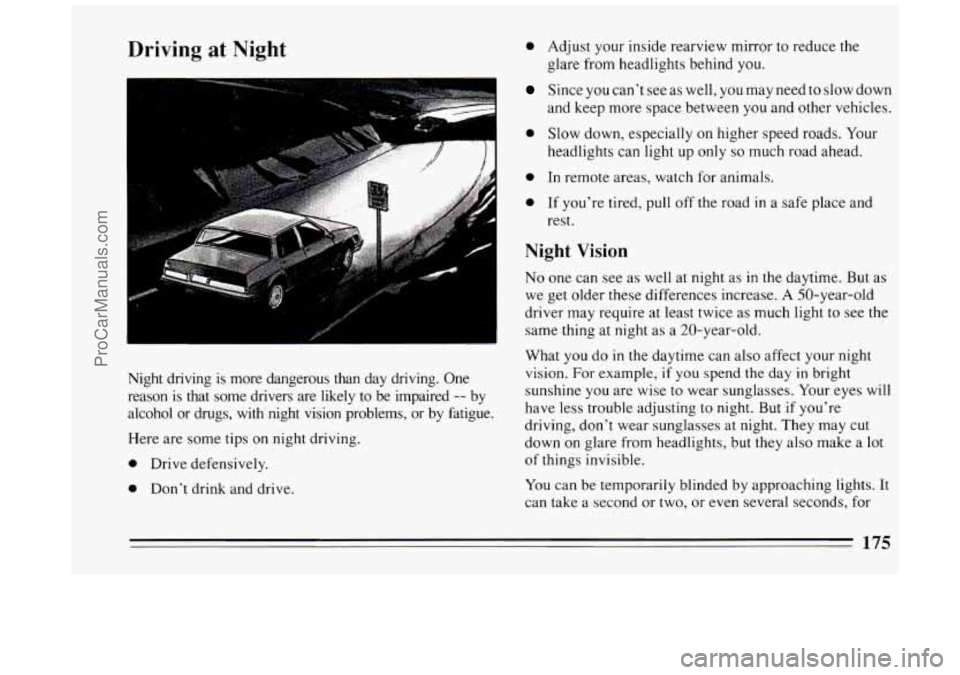
Driving at Night
rn
.. .
0 Adjust your inside rearview mirror to reduce the
glare from headlights behind you.
Since you can’t see as well, you may need to slow down
and keep more space between you and other vehicles.
0 Slow down, especially on higher speed roads. Your
headlights can light up only
so much road ahead.
0 In remote areas, watch for animals.
0 If you’re tired, pull off the road in a safe place and
rest.
Night Vision
Night driving is more dangerous than day driving. One
reason is that some drivers are likely to be impaired
-- by
alcohol or drugs, with night vision problems, or by fatigue.
Here are some tips on night driving.
0 Drive defensively.
0 Don’t drink and drive. No
one can see as well at night as in the daytime. But as
we get older these differences increase. A 50-year-old
driver may require at least twice as much light to see the
I same thing at night as a 20-year-old.
What you do in the daytime can also affect your night
vision. For example,
if you spend the day in bright
sunshine you are wise to wear sunglasses. Your eyes will
have less trouble adjusting to night. But
if you’re
driving, don’t wear sunglasses at night. They may cut
down on glare from headlights, but they also make a lot
of things invisible.
You can be temporarily blinded by approaching lights. It
can take a second or two, or even several seconds, for
175
ProCarManuals.com
Page 178 of 324
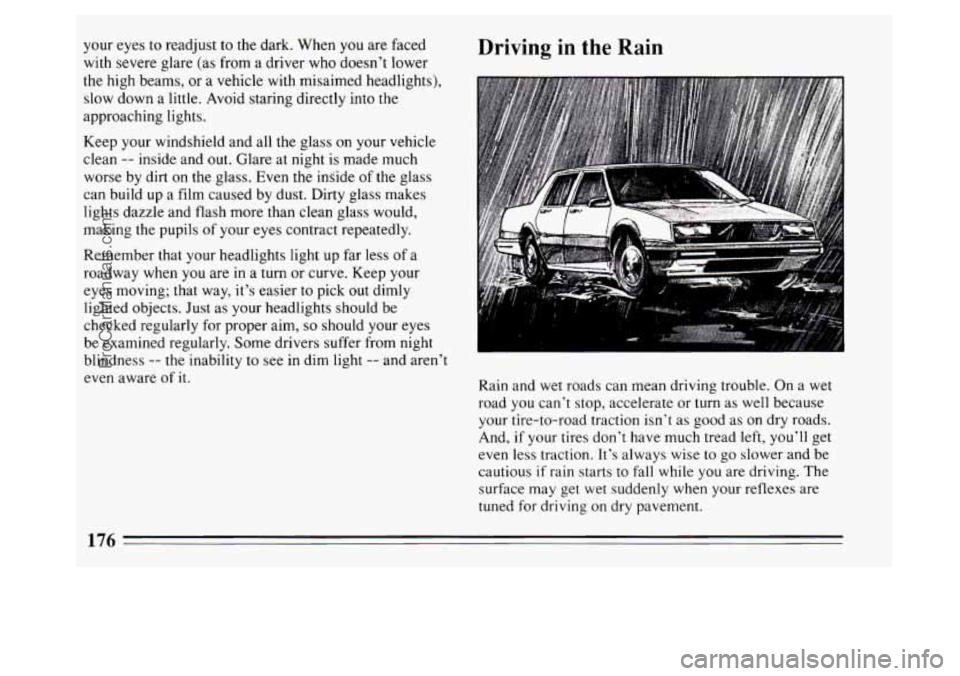
your eyes to readjust to the dark. When you are faced
with severe glare (as from a driver who doesn’t lower
the high beams, or a vehicle with misaimed headlights),
slow down a little. Avoid staring directly into the
approaching lights.
Keep your windshield and all the glass on your vehicle
clean
-- inside and out. Glare at night is made much
worse by dirt
on the glass. Even the inside of the glass
can build up a film caused by dust. Dirty glass makes
lights dazzle and flash more than clean glass would,
making the pupils of your eyes contract repeatedly.
Remember that your headlights light up far less of a
roadway when you are
in a turn or curve. Keep your
eyes moving; that way, it’s easier to pick out dimly
lighted objects. Just as your headlights should be
checked regularly for proper aim,
so should your eyes
be examined regularly. Some drivers suffer from night
blindness
-- the inability to see in dim light -- and aren’t
even aware
of it.
Driving in the Rain
Rain and wet roads can mean driving trouble. On a wet
road you can’t stop, accelerate or turn as well because
your tire-to-road traction isn’t as good
as on dry roads.
And,
if your tires don’t have much tread left, you’ll get
even less traction. It’s always wise to go slower and be
cautious
if rain starts to fall while you are driving. The
surface may get wet suddenly when your reflexes are
tuned for driving
on dry pavement.
176
ProCarManuals.com
Page 180 of 324
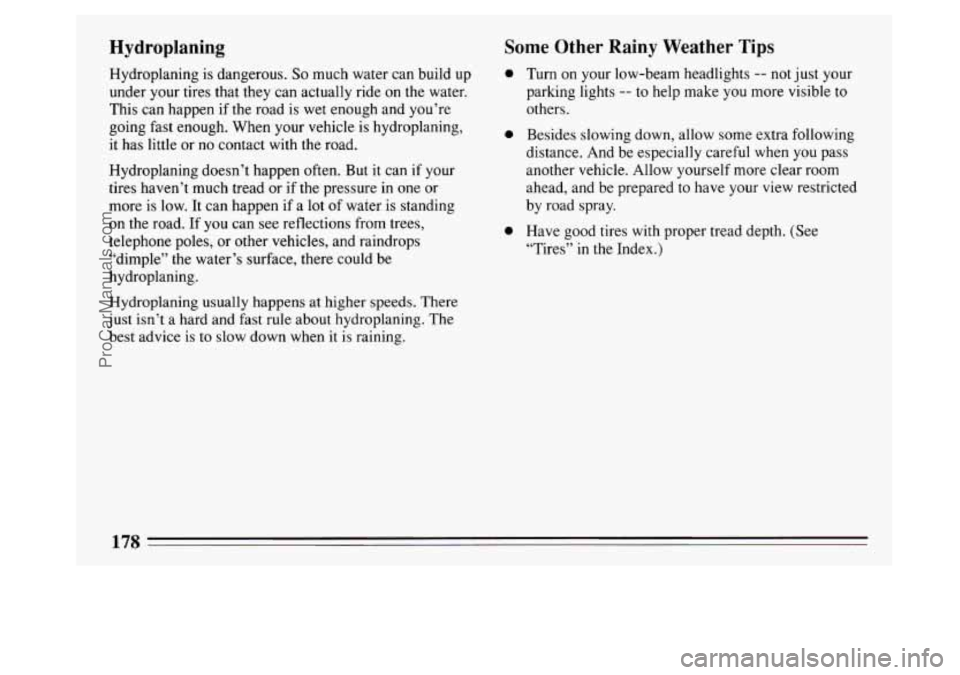
Hydroplaning
Hydroplaning is dangerous. So much water can build up
under your tires that they can actually ride on the water.
This can happen if the road is wet enough and you’re
going fast enough. When your vehicle is hydroplaning,
it has little or no contact with
the road.
Hydroplaning doesn’t happen often. But it can
if your
tires haven’t much tread or if the pressure in
one or
more is low. It can happen if a lot of water is standing
on the road. If you can see reflections from trees,
telephone poles, or other vehicles, and raindrops
“dimple” the water’s surface, there could be
hydroplaning.
Hydroplaning usually happens at higher speeds. There
just isn’t a hard and fast rule about hydroplaning. The
best advice is
to slow down when it is raining.
Some Other Rainy Weather Tips
0
0
0
Turn on your low-beam headlights -- not just your
parking lights
-- to help make you more visible to
others.
Besides slowing down, allow some extra following
distance. And be especially careful when
you pass
another vehicle. Allow yourself more clear room
ahead, and be prepared
to have your view restricted
by road spray.
Have good tires
with proper tread depth. (See
“Tires” in the Index.)
178
ProCarManuals.com
Page 190 of 324

Run your engine only as long as you must. This saves
fuel. When you run the engine, make it go a little faster
than just idle. That is, push the accelerator slightly. This
uses less fuel
for the heat that you get and it keeps the
battery charged.
You will need a well-charged battery to
restart the vehicle, and possibly for signaling later
on
with your headlights. Let the heater run for awhile.
Then, shut the engine off and close the window almost
all the way to preserve the heat. Start the engine again
and repeat this only when
you feel really uncomfortable
from the cold. But
do it as little as possible. Preserve the
fuel as long as you can. To help keep warm, you can get
out of the vehicle and do some fairly vigorous exercises
every half hour or
so until help comes.
Towing a Trailer
NOTICE:
Pulling a trailer improperly can damage your
vehicle and result in costly repairs not covered
by your warranty.
To pull a trailer correctly, follow
the advice in this section, and see your Buick
dealer for important information about towing
a
trailer with your vehicle .
188
ProCarManuals.com